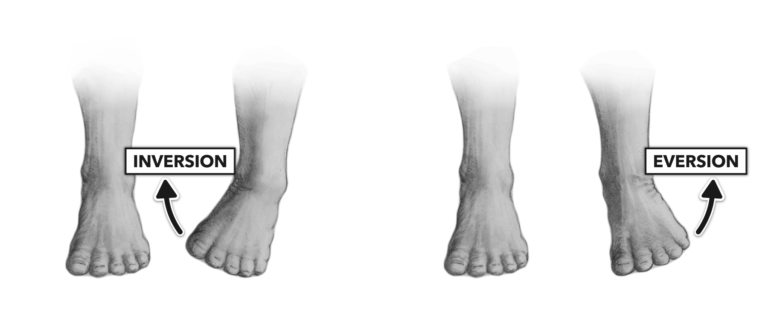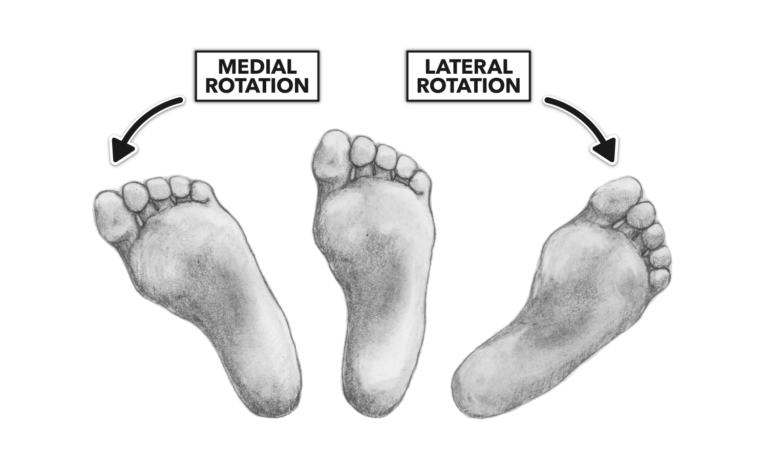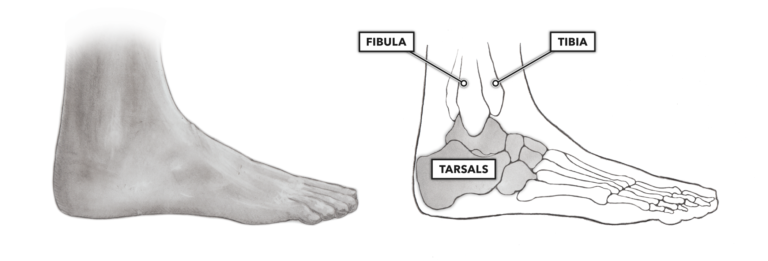The ankle joint is comprised of two long bones — the tibia and the fibula — as well as underlying tarsal bones. There are seven tarsal bones in each foot. In total, the ankle allows the foot to move in six different ways: dorsiflexion, plantarflexion, inversion, eversion, and medial and lateral rotation.
Flexion and extension at the ankle are referred to as dorsiflexion and plantarflexion, respectively (Figure 2). “Dorsi” refers to the top of the foot, while “plantar” refers to the bottom of the foot. The term “flexion” is incorporated to indicate movement upwards (dorsiflex) or downwards (plantarflex). Dorsiflexion occurs when you lift the forward portion of the foot up (rocking back on your heels with the balls of your feet elevated). Plantarflexion occurs when you push the forward portion of the foot down (raising your heels off the ground as you go up on the balls of your feet).
Dorsiflexion is a normal part of squatting down toward the ground, while plantarflexion is a normal part of standing up. Essentially, any ground-based exercise has both dorsiflexion and plantarflexion as an element of movement.

Figure 2: Flexion and extension at the ankle are referred to as dorsiflexion and plantarflexion.
The ankle also facilitates side-to-side movements of the foot known as inversion (rolling the sole of the foot to face medially) and eversion (rolling the sole of the foot to face laterally), as depicted in Figure 3. In comparing these movements to the movements of the wrist and hand, we can see that supination and pronation are analogous movements.

Figure 3: Inversion and eversion of the ankle
Rotation at the ankle provides a limited range of motion centered on the heel. If you sit down, keep your heel on the ground, and slightly lift the ball of the foot off the ground (dorsiflexion), you can pivot the foot medially (internal rotation) and laterally (external rotation), as shown in Figure 4. This is a small range of motion, as the bony structure of the ankle limits excursion in both directions. The largest rotation of the foot occurs via the hip joint. You can compare the difference in the ranges of motion of these two separate joints by standing and performing internal and external rotation to demonstrate hip mobility, then sitting and observing ankle mobility as described above.

Figure 4: Internal and external rotation at the ankle are referred to as medial and lateral rotation.
Additional Reading
- Movement About Joints, Part 1: The Shoulder
- Movement About Joints, Part 2: The Elbow
- Movement About Joints, Part 3: The Wrist
- Movement About Joints, Part 4: The Hand and Fingers
- Movement About Joints, Part 5: The Hip
- Movement About Joints, Part 6: The Knee
- Movement About Joints, Part 8: The Vertebral Column
Comments on Movement About Joints, Part 7: The Ankle
Thank you for the excellent post. I‘d propose to put in some ideas on specific instructions for foot work. E.g. tibialis posterior training as a base for proper lifting. L
Lukas. Although isolation movement can be used sometimes, the methodology of CrossFit focuses on full body, compound movements (Functional movements) so we would improve foot work by squatting, jumping, throwing, lunging etc..

Movement About Joints, Part 7: The Ankle
2